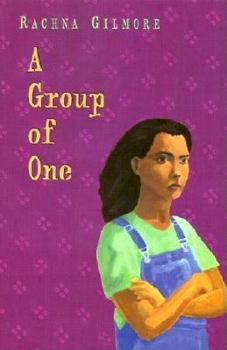A Group of One
Select Format
Select Condition 
Book Overview
A girl of mixed heritage discovers that both cultures are important parts of who she is. "Mr. Toller grins. "I guess we plain old regular Canadians need to know the history of other places to get a real and balanced view.""Plain old regular."As in white."It jolts through me like lightning. I almost bought his idea of regular--that's why I was afraid to read my grandmother's story. "My heart pounds, but I have to say it.""Mr. Toller, I AM a regular Canadian." "Hey, Tara, what's your mother tongue? It's questions like these that make fourteen-year-old Tara Mehta boil, especially when they're asked by teachers who ought to know better. Yes, her parents were raised in India, but Tara has lived in Ottawa her whole life -- she's as Canadian as everybody else. There are much more important things than where her family came from. Jeff, for instance. He's the new guy with the blue eyes and a brain that actually works. But then she meets her grandmother for the first time. Naniji fought with Gandhi in the Indian Indepence movement, and she's horrified to learn that her grandchildren know almost nothing about their heritage. Tara resents her grandmother's attitude until she learns how Naniji came to join the fight for indepence. Shocked and angered by the history that she's never been taught in school, Tara decides to tell Naniji's story to her class. In the wake of the violently mixed reactions that follow, Tara comes to realize that most people need to expand their definition of what it means to be a "regular" Canadian -- including herself.
Format:Hardcover
Language:English
ISBN:0805064753
ISBN13:9780805064759
Release Date:July 2001
Publisher:Henry Holt & Company
Length:192 Pages
Weight:0.82 lbs.
Dimensions:0.7" x 5.8" x 8.7"
Age Range:11 to 15 years
Grade Range:Grades 6 to 10
Customer Reviews
1 rating
Highly Recommended - for kids, parents and gransparents!
Published by Thriftbooks.com User , 22 years ago
The novel, written for kids 9 and over, is primarily about the upheavals that occur in the life of an Indian-Canadian family when the grandmother (Naniji) visits from India. The protagonist is Tara a lively and sensitive 15-year-old. She is initially resentful of her visiting grandmother because the grandmother seems to disapprove of Tara's mother's somewhat Western ways and indeed of the Canadian ways of the whole family: the kids don't know Hindi, nor about Diwali; they don't play the sitar and, worst of all, know nothing of the family's role and sacrifice during the Indian Independence movement. This is too much for Tara: "This is the world I live in. But how do I fit? I'm not one of the true natives, the First Nations, and not one of the whites who marauded the globe colonizing, who tell the history of Canada from when they arrived. I'm too dark for the Samanthas and the rednecks, but not dark enough for Tolly, or Indian enough for Naniji, too Canadian, too Western. Always too something. Never just right."Tara reads a paper at school about Naniji's role in the Indian Independence movement. The most evocative part of the book occurs when Tara alternates between wanting to read the paper to her class, and not wanting to because of how her friends will react to it and to her (how it will affect her acceptance within the group). She reads the paper anyway. As she had feared, some of her classmates do "shutter down" - close up by seeming to brand her as "other". But, unexpectedly, some of them actually congratulate her and thank her for introducing her to an aspect of history and of herself of which they had been unaware.Her mother and Naniji are proud of her - that is, until Naniji hears Tara proclaim how she, Tara, is a "regular" Canadian. At this point Naniji "shutters down" because she cannot countenance the fact that her granddaughter is a proud Canadian - what of the family's heritage, sacrifice and history back in India? What of their allegiance to India? "Naniji catches me staring and tries to smile. She's stiff, but it's not like before, with the criticism and disapproval and the hostility. Her eyes - they are hurt."The resolution of the conflict within the family and within Tara's own mind is handled by Ms. Gilmore with great maturity and eloquence. She articulates opposing points of view with clarity and grace. Without talking down to the reader, she addresses sensitive issues such as race and color, assimilation and alienation, head-on. This is important especially because these issues are hardly ever addressed in a safe, non-ideological way, without putting one or the other side down as the victim or the aggressor, the turncoat or the conservative.I highly recommend this book - not just for kids in this age group, but even for their parents and grandparents. In fact, I would go so far as to say this book should be made required reading for all kids (on any rung of the assimilation ladder) because it will create a better understanding





